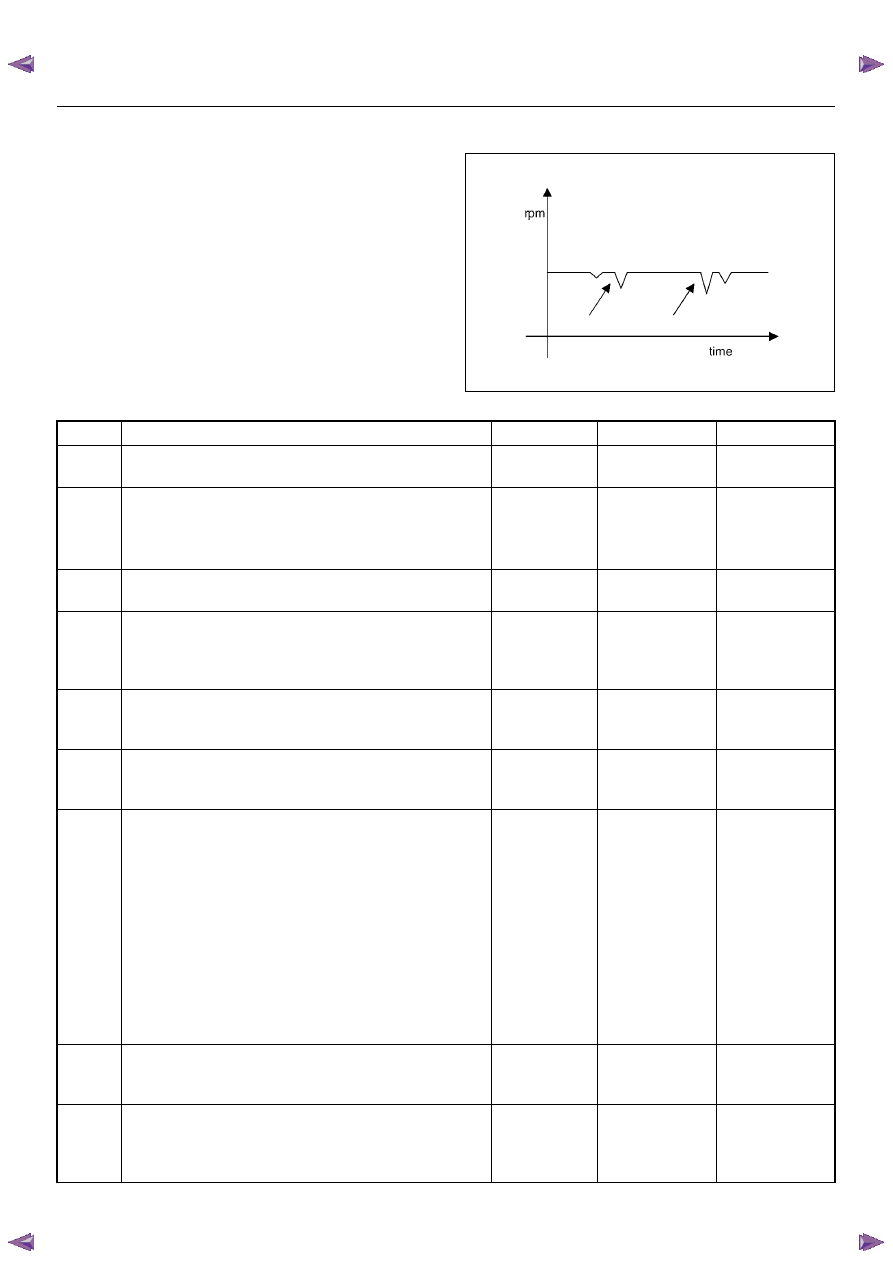Isuzu KB P190. Manual — part 604

6E–246
ENGINE DRIVEABILITY AND EMISSIONS
10
Monitor “B1S1 (Bank 1 Sensor 1) Status” on the Tech
2.
Is the “B1S1 (Bank 1 Sensor 1) Status” in the rich
condition?
—
Go to Step 11
Go to Step 12
11
Check items that can cause the engine to run rich.
Refer to DTC P1167 “Fuel Supply System Rich During
Deceleration Fuel Cut Off”.
Was a problem found?
—
Verify repair
Go to Step 12
12
Check items that can cause the engine to run lean.
Refer to DTC P1171 “Fuel Supply System Lean
During Power Enrichment”.
Was a problem found?
—
Verify repair
Go to Step 13
13
Check for proper ignition voltage output with the spark
tester.
Was a problem found?
—
Verify repair
Go to Step 14
14
Check for a loose ignition control module ground.
Was a problem found?
—
Verify repair
Go to Step 15
15
Visually/physically inspect all spark plug high-tension
cables. Check for the following conditions:
• Verify that the resistance of all spark plug high-
tension cables are less than the specified value.
• Verify that the all spark plug high-tension cables are
correctly fitted to eliminate cross-fitting.
• Verify that the all spark plug high-tension cables are
not arcing to ground.
Spraying the spark plug high-tension cables with a
light mist of water may help locate an intermittent
problem.
Was a problem found?
#1 cyl. 4.4k
Ω
#2 cyl. 3.6k
Ω
#3 cyl. 3.1k
Ω
#4 cyl. 2.8k
Ω
Verify repair
Go to Step 16
16
1. Check the ignition coil secondary resistance.
2. Replace the coil if it is greater than the specified
resistance.
Did the coil require replacement?
2.5k
Ω
Verify repair
Go to Step 17
17
1. Remove the spark plugs and check for gas or oil
fouling cracks, wear, improper gap, burned
electrodes, heavy deposits, or improper heat
range.
2. If spark plugs are fouled, the cause of fouling must
be determined before replacing the spark plugs.
Was a problem found?
—
Verify repair
Go to Step 18
18
Check the ECM grounds to verify that they are clean
and tight. Refer to the ECM wiring diagrams.
Was a problem found?
—
Verify repair
Go to Step 19
19
Visually/physically check the vacuum hose for splits,
kinks and proper connections and routing.
Was a problem found?
—
Verify repair
Go to Step 20
Step
Action
Value(s)
Yes
No

ENGINE DRIVEABILITY AND EMISSIONS
6E–247
20
1. Review all diagnostic procedures within this table.
2. If all procedures have been completed and no
malfunctions have been found, review/inspect the
following:
• Visual/physical inspection
• Tech 2 data
• All electrical connections within a suspected
circuit and/or system
Was a problem found?
—
Verify repair
Go to Step 21
21
Is the ECM programmed with the latest software
release?
If not, download the latest software to the ECM using
the “SPS (Service Programming System)”.
Was the problem solved?
—
Verify repair
Go to Step 22
22
Replace the ECM.
Is the action complete?
IMPORTANT: The replacement ECM must be
programmed. Refer to section of the Service
Programming System (SPS) in this manual.
Following ECM programming, the immobilizer system
(if equipped) must be linked to the ECM. Refer to
section 11 “Immobilizer System-ECM replacement” for
the ECM/Immobilizer linking procedure.
—
Verify Repair
—
Step
Action
Value(s)
Yes
No

6E–248
ENGINE DRIVEABILITY AND EMISSIONS
CUTS OUT, MISSES SYMPTOM
DEFINITIONS: Steady pulsation or jerking that follows
engine speed; usually more pronounced as engine load
increases.
Step
Action
Value(s)
Yes
No
1
Was the “On-Board Diagnostic (OBD) System Check”
performed?
—
Go to Step 2
Go to OBD
System Check
2
1. Perform a bulletin search.
2. If a bulletin that addresses the symptom is found,
correct the condition as instructed in the bulletin.
Was a bulletin found that addresses the symptom?
—
Verify repair
Go to Step 3
3
Was a visual/physical check performed?
—
Go to Step 4
Go to Visual /
physical Check.
4
Check the ECM grounds to verify that they are clean
and tight. Refer to the ECM wiring diagrams in
Electrical Diagnosis.
Was a problem found?
—
Verify repair
Go to Step 5
5
Check for a loose or short circuit of ignition coil
module voltage feed.
Was a problem found?
—
Verify repair
Go to Step 6
6
Check for a loose or short circuit of ignition coil
module ground.
Was a problem found?
—
Verify repair
Go to Step 7
7
Visually/physically inspect all spark plug high-tension
cables. Check for the following conditions:
• Verify that the resistance of all spark plug high-
tension cables are less than the specified value.
• Verify that the all spark plug high-tension cables are
correctly fitted to eliminate cross-fitting.
• Verify that the all spark plug high-tension cables are
not arcing to ground.
Spraying the spark plug high-tension cables with a
light mist of water may help locate an intermittent
problem.
Was a problem found?
#1 cyl. 4.4k
Ω
#2 cyl. 3.6k
Ω
#3 cyl. 3.1k
Ω
#4 cyl. 2.8k
Ω
Verify repair
Go to Step 7
8
Check the CKP sensor wire, shield wire, or installation
condition.
Was a problem found?
—
Verify repair
Go to Step 9
9
Monitor “B1S1 (Bank 1 Sensor 1) Status” on the Tech
2.
Is the “B1S1 (Bank 1 Sensor 1) Status” in the rich
condition?
—
Go to Step 10
Go to Step 11

ENGINE DRIVEABILITY AND EMISSIONS
6E–249
10
Check items that can cause the engine to run rich.
Refer to DTC P1167 “Fuel Supply System Rich During
Deceleration Fuel Cut Off”.
Was a problem found?
—
Verify repair
Go to Step 11
11
Monitor “B1S1 (Bank 1 Sensor 1) Status” on the Tech
2.
Is the “B1S1 (Bank 1 Sensor 1) Status” in the lean
condition?
—
Go to Step 12
Go to Step 13
12
Check items that can cause the engine to run lean.
Refer to DTC P1171 “Fuel Supply System Lean
During Power Enrichment”.
Was a problem found?
—
Verify repair
Go to Step 13
13
1. Visually/physically inspect for the following
conditions:
• Restriction of air intake system. Check for a
restricted air filter element, or foreign objects
blocking the air intake system.
• Check for objects blocking the IAC passage or
throttle bore, excessive deposits in the throttle
bore and on the throttle plate.
• Check for a condition that causes a large
vacuum leak, such as an incorrectly installed or
faulty crankcase ventilation hose/brake booster
hose.
Was a problem found?
—
Verify repair
Go to Step 14
14
Check the injector connectors, if any of the injectors
are connected an incorrect cylinder, correct as
necessary.
Was a problem found?
—
Verify repair
Go to Step 15
15
Perform the “Injector Coil/Balance Test” (Refer to 6E-
98 page).
Was a problem found.
—
Verify repair
Go to Step 16
16
1. Check for fuel in the pressure regulator vacuum
hose.
2. If fuel is present, replace the fuel pressure
regulator assembly.
Was a problem found?
—
Verify repair
Go to Step 17
17
Check for proper ignition voltage output with the spark
tester.
Was a problem found?
—
Verify repair
Go to Step 18
18
1. Remove the spark plugs and check for gas or oil
fouling cracks, wear, improper gap, burned
electrodes, heavy deposits, or improper heat
range.
2. If spark plugs are fouled, the cause of fouling must
be determined before replacing the spark plugs.
Was a problem found?
—
Verify repair
Go to Step 19
Step
Action
Value(s)
Yes
No

Нет комментариевНе стесняйтесь поделиться с нами вашим ценным мнением.
Текст